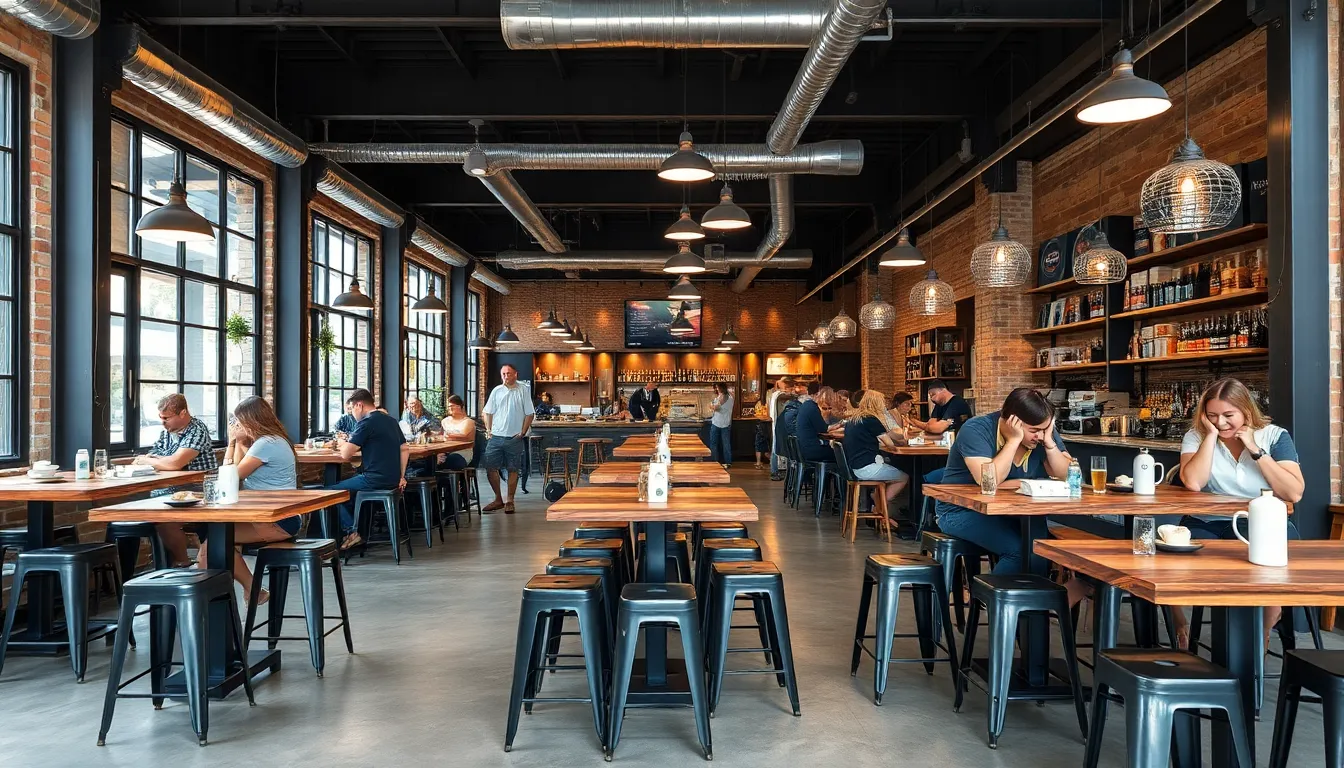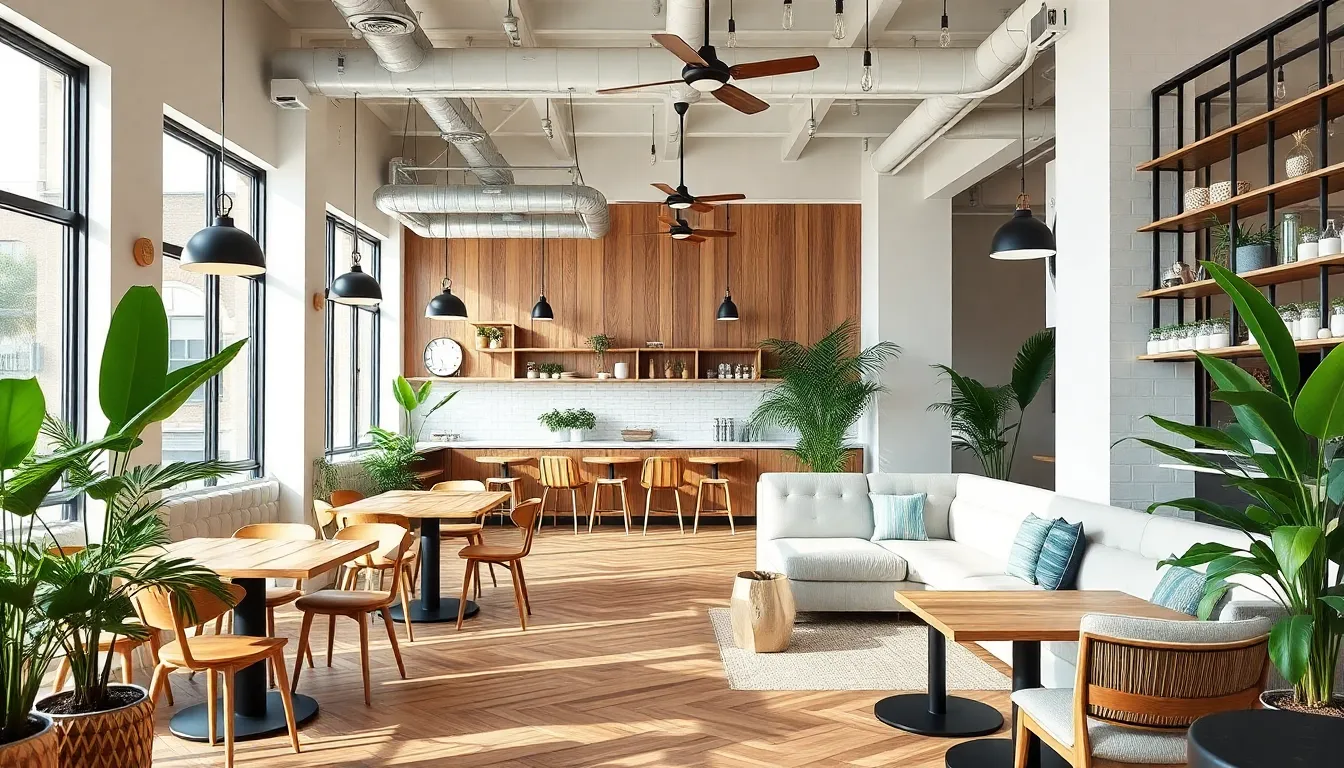Industrial furniture once dominated modern interiors with its raw materials and minimalist edge. Exposed metal, reclaimed wood and utilitarian designs brought a sense of urban cool to homes and offices across the UK. But as trends shift and new styles emerge, many wonder if industrial furniture still has a place in today’s interiors.
Homeowners and designers keep searching for fresh ways to express personality and comfort. With so many options available, it’s easy to question whether industrial furniture is still on trend or fading into the background. Exploring the current landscape reveals if this iconic style still holds its appeal or if it’s time to support something new.
Understanding Industrial Furniture Design
Industrial furniture design uses robust materials like steel, iron, and reclaimed timber. Surfaces show visible bolts, welded joints, and distressed finishes. Features like exposed frames and textured grains create a functional look, referencing factories and warehouses from 20th-century Europe and North America.
Australian hospitality venues often select industrial furniture for durability in high-traffic environments. Stools, benches, and communal tables made with powder-coated steel frames and solid timber tops suit cafes and restaurants in Queensland. Neutral shades like grey or black pair well with rustic woods, giving a cohesive appearance and supporting diverse decor updates.
Cafe Solutions supplies commercial-grade industrial furniture across Queensland. Products like Tolix chairs and bar tables meet safety and stability requirements for hospitality settings. Stocked items include stackable options for easy storage and custom finishes tailored to client needs.
Industrial design continues to attract operators wanting resilient and easy-to-maintain furnishings. Owners use modular seating, counter stools, and compact tables to maximise small footprints without sacrificing practicality. In busy city areas, industrial looks offer longevity and straightforward cleaning, reducing downtime between customer turnovers.
The Rise and Popularity of Industrial Furniture

Industrial furniture gained strong popularity in the UK’s hospitality sector during the early 2010s as operators searched for durable, low-maintenance solutions. Designers used steel, iron, and reclaimed wood in bar stools, communal tables, and shelving units, preferring finishes that could withstand heavy use. Busy cafés and urban restaurants selected bench seating with exposed metal legs, visible welds, and reinforced edges to maintain a cohesive, functional look. Practicality and longevity were the primary purchase drivers in workspaces and dining areas.
Australians adopted industrial furniture in premium settings. Major suppliers, including Cafe Solutions in Queensland, offered powder-coated steel stools and sturdy hardwood tables that met safety and compliance requirements for commercial venues. Clients received customisation options on finish, height, and protective features. Operators prioritised materials like high-density fibreboard and impact-resistant edges for resilience in high-traffic environments such as cafeterias, food courts, and boutique cafés.
Distinctive industrial design elements became visible across city hospitality venues, with many spaces relying on dark metallic frames and timber accents to establish a warehouse-inspired aesthetic. Operators valued the consistent appearance and adaptability, allowing frequent rearrangement for flexible seating plans. Industrial furniture maintained relevance due to robust construction and adaptability for venues needing efficient, low-cost maintenance.
Current Trends in Interior Design

Current interior design trends reflect a move towards versatile and flexible concepts. Commercial spaces and urban homes both respond to changes in material demand and design influences.
Shifting Preferences in Materials and Styles
Contemporary interior design trends show growing use of lighter wood finishes, soft neutral palettes, and upholstered furniture. Eucalyptus, ash, and oak exemplify timber choices that appear frequently in recent cafe and restaurant refurbishments. Demand for powder-coated steel drops in some city projects, with brass, matte black, and organic materials becoming preferred accents. Industrial elements—visible bolts or metal legs—still appear, but designers increasingly blend these features with softer surfaces for comfort. Queensland hospitality venues sometimes combine reclaimed timber tops and contemporary frames for balance between durability and warmth. Cafe Solutions offers product lines with customisable seating and finishes, meeting requirements for both modern aesthetics and heavy daily use.
Influence of Social Media and Designers
Current trends in furniture selection reflect direct influence from social media platforms and prominent interior designers. Instagram and Pinterest popularise cafe interiors showcasing light wood, pastel tones, and minimalist décor in both Australian and UK markets. Design firms highlight photos of venues using curved seating, textured fabrics, and biophilic features. Industrial elements rarely disappear entirely, but influencers highlight integrated designs where functional pieces—such as powder-coated stools—pair with greenery or pendant lighting. Cafe Solutions monitors these trends closely, adjusting its commercial inventory to provide steel and timber items in updated colourways, sizes, and upholstery options in Queensland. Designers specify brands and models through social channels, accelerating the spread of updated looks in hospitality venues.
Is Industrial Furniture Out of Style?
Contemporary interiors increasingly prioritise comfort and personalisation, yet industrial furniture maintains specific advantages in commercial design. The aesthetic’s presence in hospitality spaces remains, but the context of its use continues to change.
Signs of Declining Popularity
Market data and trend analysis show reduced demand for purely industrial styles in new commercial projects. Designers prefer lighter wood finishes, upholstered seating, and softer hues over exposed metal and dark timber. In 2023, Google Trends indicated a 20% fall in searches for “industrial bar stools“ and “industrial café tables“ across Australia when compared with 2018. Modern fitouts for cafés in Brisbane and Melbourne often replace metal stools with oak chairs and pastel accents. Cafe Solutions in Queensland responds by expanding its selection of contemporary seating options, adding new colours and finishes to meet shifting aesthetic preferences.
Areas Where Industrial Furniture Remains Relevant
Durability requirements keep industrial furniture in demand in high-traffic venues. Brisbane cafés, restaurants, and food courts select powder-coated steel tables, bar stools and communal benches for their resilience against frequent repositioning and cleaning. Hospitality operators favour metal-framed bases and timber tops sourced from Cafe Solutions, especially in settings requiring quick maintenance and extended service life. Rural eateries, school tuckshops, and event halls also opt for industrial tables due to efficient wipe-down surfaces and low repair costs. Customisation options from Cafe Solutions, including different stains and reinforced welded frames, ensure ongoing suitability for commercial clients across urban and regional Queensland.
Alternatives to Industrial Furniture
Designers in the hospitality sector increasingly look to new concepts that respond to shifting preferences for warmth, comfort and adaptability. Modern café and restaurant interiors now prioritise inviting finishes, lighter materials, and practical configurations, reflecting recent demand patterns in Queensland and across Australia.
Emerging Trends Replacing Industrial Aesthetics
Softwood furniture, for example ash and oak chairs, has become common in recent fitouts, replacing dark metals and raw finishes. Upholstered seating, visible in banquette benches and cushioned dining chairs, now dominates urban café interiors for enhanced guest comfort. Neutral colour palettes and understated pastel tones, influenced by social media trends, drive the popularity of flexible tables and stools in bisque or sage. Queensland suppliers like Cafe Solutions respond by expanding commercial inventory with updated timber and laminate options, ensuring products that meet safety standards and suit modern hospitality requirements. Rounded-edge tables and stackable seating offer easy maintenance and adaptability for busy venues.
How to Blend Industrial with Modern Styles
Mixing industrial elements remains practical for venues aiming to balance durability with softer aesthetics. Operators often pair powder-coated steel frames, available through Cafe Solutions, with upholstered seats or timber tabletops to increase guest comfort in high-traffic areas. Designers use black or charcoal bases under pastel or light wood surfaces, creating a less stark look while retaining commercial resilience. Introducing textured fabrics and indoor greenery moderates the harshness of metal or cement features. This approach fits Queensland’s hospitality sector, where durability and efficient maintenance stay critical. Such blended concepts allow café and restaurant owners to customise fitouts without compromising comfort or everyday usability, leveraging the established strengths of industrial furniture in a contemporary setting.
Conclusion
While design trends will always evolve industrial furniture continues to offer a unique combination of resilience and character that appeals to both commercial and residential spaces. Its ability to blend with softer materials and contemporary touches ensures it remains a flexible choice for those seeking longevity and style. For venues prioritising durability and easy upkeep industrial pieces still deliver practical value even as tastes shift toward lighter and more personalised interiors.
Frequently Asked Questions
What is industrial furniture?
Industrial furniture is characterised by its use of raw, robust materials such as steel, iron, and reclaimed wood. It often features exposed bolts, welded joints, and distressed finishes, evoking the look of early 20th-century factories and warehouses.
Is industrial furniture still in style?
While pure industrial styles are less popular now, industrial furniture remains relevant in commercial spaces for its durability. Many designers now blend industrial elements with softer finishes to balance comfort and practicality.
Why is industrial furniture popular in hospitality venues?
Industrial furniture is favoured in cafés and restaurants for its resilience, low maintenance, and ability to withstand frequent use. Its robust construction makes it ideal for high-traffic areas, especially in the hospitality sector.
How is the industrial furniture trend evolving?
Current trends favour lighter wood finishes, soft neutral palettes, and upholstered seating. Designers increasingly combine industrial pieces with modern materials and colours to suit contemporary tastes while still benefiting from industrial durability.
What are some alternatives to industrial furniture?
Popular alternatives include chairs and tables made from softwoods like ash and oak, and upholstered seating for added comfort. Neutral tones and pastel colourways have also become more prominent, reflecting trends seen on social media.
Can industrial furniture be customised to fit modern interiors?
Yes, many suppliers offer customisation options for industrial furniture, such as updated colour finishes, timber accents, and upholstered seats. This allows venues to blend industrial strength with current design preferences.
Are there any downsides to using industrial furniture?
The main drawback is that pure industrial styles can sometimes feel cold or outdated in modern interiors. However, blending industrial elements with warmer materials and colours can overcome this and enhance comfort.
How is social media influencing furniture choices in cafés and restaurants?
Platforms like Instagram and Pinterest are popularising lighter woods, pastel tones, and minimalist décor. Hospitality operators are updating their interiors with these trends, moving away from exclusively industrial looks.
Is industrial furniture suitable for homes, or just commercial spaces?
Industrial furniture can work in homes, especially as statement pieces or in urban loft-style settings. However, many homeowners now prefer to balance industrial elements with softer textures and lighter colours for greater comfort.
Why do some venues still prefer industrial furniture despite changing trends?
Industrial furniture’s main appeal is its durability and low maintenance, making it practical for high-traffic venues. Customisation and blending with modern styles help keep it relevant and adaptable to changing design requirements.

